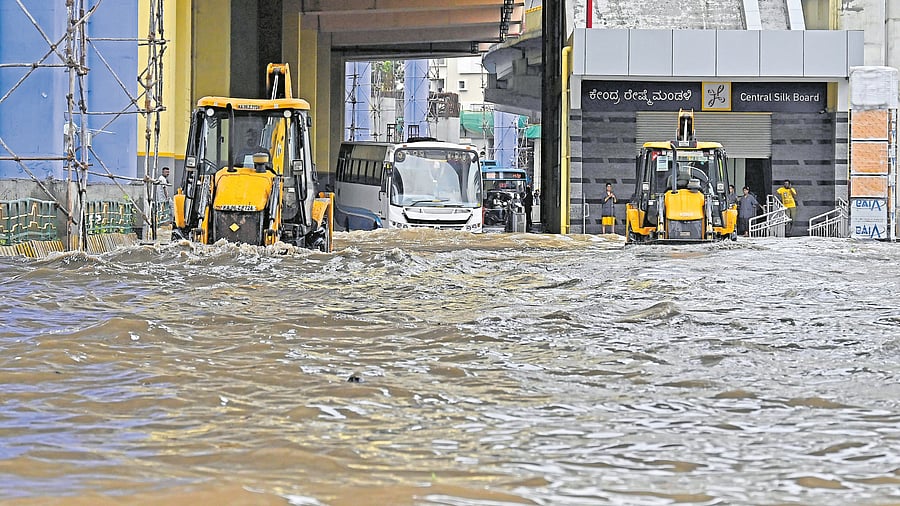
Flooded streets bring traffic to a standstill. A bus stranded at Silk Board junction after heavy rains in Bengaluru on Monday, May 19, 2025.
Credit: DH PHOTO/Pushkar V
India’s recent brush with extreme weather reinforces urgent reality climate disruptions are no longer seasonal outliers; they are becoming routine. Just a week apart, two of our key metropolitan centres were hit hard. First, Bengaluru was battered by an unusually heavy downpour that inundated major roads and IT corridors, crippling transport, and business operations. Within days, Mumbai normally dry in May was swamped by unseasonal rain that flooded streets, stalled vehicles, and caused a spike in motor insurance claims. These events, unfolding in rapid succession, serve as a warning: climate volatility is escalating, and the risks are getting more complex.
India’s diverse geography makes it especially vulnerable to climate change. The country is experiencing more frequent floods, prolonged heatwaves, erratic monsoons, and stronger cyclones. For the insurance industry, these events are not just natural disasters, they are financial shocks that demand a fundamental rethink of risk assessment, underwriting, and claims management.
Major incidents like Cyclone Amphan, floods in Assam and Kerala, and extended heatwaves across North India have already caused significant losses particularly in the crop and motor insurance segments. These two categories are increasingly exposed to the consequences of climate unpredictability.
In agriculture, erratic rainfall, delayed monsoons, droughts, and flash floods have pushed up claim ratios under government-backed schemes like the PM Fasal Bima Yojana (PMFBY). Traditional risk models based on historical rainfall and yield averages are proving inadequate. There is now a critical need for more dynamic, hyper-local, real-time data to guide premium pricing, claim validation, and underwriting.
In the motor insurance space, urban flooding and cyclonic winds are damaging vehicles in large numbers, especially in cities with aging drainage systems. As these events become more common, traditional underwriting assumptions are being challenged and loss ratios are rising.
To adapt, insurers are increasingly shifting to granular, data-driven risk models. In flood-prone cities, engine protect, zero depreciation, and return-to-invoice add-ons are being strongly recommended especially for cars parked in low-lying or waterlogged areas. Telematics-based tracking, real-time weather alerts, and geolocation-sensitive underwriting are helping companies respond faster and more accurately.
In agriculture, parametric insurance solutions where claims are triggered automatically by pre-defined weather thresholds are proving effective in ensuring faster and more transparent settlements. These are especially useful in remote or disaster-hit regions, where traditional assessments may be delayed or impossible.
Another critical focus is on encouraging climate-resilient behaviour. Farmers using drought-resistant seeds or soil moisture conservation techniques, and car owners adopting flood-protection technologies, should be rewarded through lower premiums or customised product offerings. Technology-driven innovation is key to facilitating this transformation.
On the regulatory front, the IRDAI’s focus on ESG compliance, green finance, and climate stress testing is a progressive step. At the same time, public-private partnerships, expanded reinsurance pools like the Crop Insurance Fund, and better data-sharing between government and insurers will be vital in making the ecosystem more resilient.
The accelerating impact of climate change on India’s insurance landscape especially in crop and motor segments is no longer a hypothetical risk. The question is not if an extreme weather event will occur, but when. Insurers must take initiative-taking responsibility to anticipate, adapt, and lead. Whether it is developing weather-indexed farm products or dynamic premiums for climate-sensitive regions, our response must be bold, inclusive, and technology-first.
The challenges are significant, but so is the opportunity to reimagine risk protection in an era of climate uncertainty. Through innovation, collaboration, and policy foresight, we can build an insurance ecosystem that not only absorbs shocks but also empowers India to move forward with greater confidence and resilience.
(The writer is CEO, Reliance General Insurance)